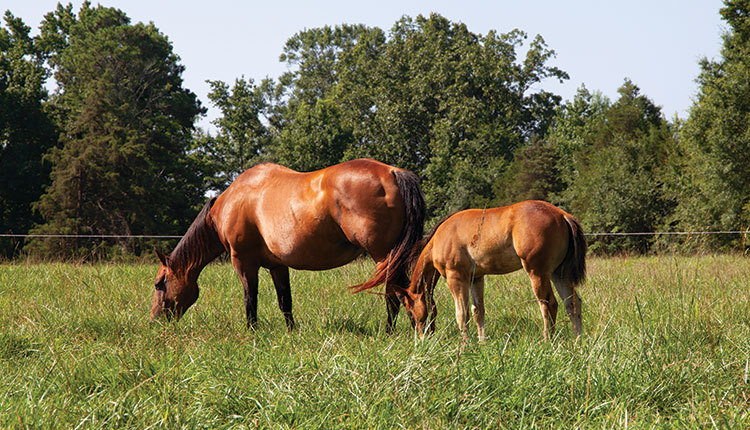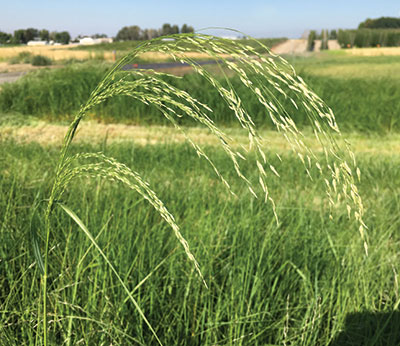Horses are getting fat — hay growers can help |
| By Natalie Shaw |
|
It’s now estimated that 20% of the U.S. horse population is obese. Low-energy hay can help solve the problem. |
The author is an equine nutritional consultant based in Missoula, Mont. She received her master’s degree from Washington State University working with teff grass It’s now estimated that 20% of the U.S. horse population is obese. Low-energy hay can help solve the problem. Most forages produced for horses are not analyzed for nutrients, and it’s understandable. For starters, many growers and distributors will not have the same lot and/or field available for long enough to warrant the hassle. It may be the extra time and expense, but also horse owners don’t often ask for or are interested in seeing a forage test. So, why test your forage products? My simple answer is that the equine industry is changing, and with it, significant margin-widening potential for hay producers. The more complicated answer is that horse owners are becoming more nutrition savvy, spending more money, and expecting more from their forage products than ever before. Not all horses are equal In order for a forage resource to be successful at any equestrian facility, it’s up to the grower/distributor and horse owner/barn manager to make a good match. This optimizes not only customer satisfaction, but also horse health and the bottom line. If you are looking for a competitive edge in the equine marketplace, you may want to consider testing your forages for calories and carbohydrates. Let’s talk about why these two values are so important. The first reason to test your forages is to ensure the right fit for your customer, and that means understanding its relative caloric density, which is also known as the digestible energy. Horses vary considerably in their activity level, size, metabolism, and living conditions. Some horses gallop for miles at the upper echelons of their sport while some get led around with children on their backs during weekends. Obviously, these horses are on extreme opposite ends of the calorie requirement spectrum. More importantly, for every existing horse owner, there is a unique way of providing horse care. Some owners may prefer to leave horses out on large pastures 24 hours per day, other horses live primarily in stalls with small turnouts, and most are provided with some combination of small pastures and smaller paddocks. Horses also live in vastly different climates and environmental conditions across the U.S. Horses’ forage needs are extremely variable, unlike dairy cattle, so, consider your primary demographic when marketing your forage crop. Horses are getting fatter One evolving change for forage growers to consider is the rise in equine obesity, its implications to equine health, and how we feed fat horses. Today, nearly one in every five U.S. equines may be at risk for complications from obesity. There are many possible factors contributing to the rise of equine obesity, but urbanization is at its heart, including greater confinement, less exercise, and higher planes of nutrition. Even as horses get fatter, they are also living longer (well into their 30s and even into their 40s) and requiring high caloric density, which means the scope of forage needs has broadened. A relatively low-calorie (not low-quality) hay may be just the right forage for overweight or obese horses, but insufficient for elite performance or geriatric horses. Therefore, do not “undervalue” your forage that may have been cut a little later than you would have liked. Again, low calorie does not imply low quality as long as the palatability and aesthetics of the forage are acceptable. The second reason to test your forage products is to understand its nonstructural carbohydrate value (NSC) for the benefit of diseased horses. Over the last several decades, veterinarians and equine nutrition researchers have gained significant knowledge about the pathology, diagnosis and treatment of several metabolic, digestive, and muscle diseases in horses that are affected by NSCs. The connection between NSCs in the horse’s diet and equine obesity is called Equine Metabolic Syndrome, which relates to insulin resistance. Anyone suffering from diabetes is familiar with the issue. Similar to humans, horses can suffer from insulin resistance, which means the body’s ability to regulate and control blood sugar is compromised. Unlike humans, the risk of insulin resistance to a horse is the threat of laminitis; this is an inflammation within the hoof capsule leading to lameness and even euthanasia in severe cases. Ultimately, laminitis is what the horse owner is trying to avoid when they purchase low NSC forages. For decades, the horse feed industry has reacted to the higher demand for “low-carb” products and profited greatly. Unfortunately, the forage industry has lagged behind this trend due to poor communication of needs and wants. Sugar to tree bark  Teff grass is a species that offers promise as a low-carb hay alternative for obese horses. Each plant species has a tendency to fluctuate in the various amounts of different types of carbohydrates, but the exact quantity of each carbohydrate can vary seasonally, daily, and even hourly in the plant. I refer to this as a plant’s “carbohydrate profile.” To grossly oversimplify, here’s one way to think about forage carbohydrates. Plant carbohydrates can be bifurcated into two categories: those that aid in the structure of the plant (structural carbohydrates) and those that do not (NSC). Nonstructural carbohydrates are broken down and absorbed relatively quickly in the equine digestive tract, which elicits a different hormonal response than do the more complex, structural carbohydrates. The latter must be digested with help from microbiota in the hindgut; this is a very different digestive system compared to ruminants. Nonstructural carbohydrates are reported on an analytical forage report in three values: water soluble carbohydrates (WSC %), ethanol soluble carbohydrates (ESC %), and starch (%). Total NSC values are reported on a dry matter basis as the sum of WSC (%) and starch (%). This is the standard value that equine nutritionists and veterinarians have chosen to use in current research trials, so, for consistency, I am suggesting similar use unless otherwise requested. What exactly does it mean for a forage to be classified as “low carb”? This is the ultimate question as neither the equine nor forage industries have led the way to a standardized definition. However, due to a small handful of equine nutrition research studies on Equine Metabolic Syndrome and obesity, the suggestion in the marketplace is 10% to 12% NSC on a dry matter basis. The average grass hay is roughly 13% across the U.S., according to Equi-Analytical’s feed profiles. I suggest that hay growers report forage products testing below 10% to be “very low carb,” between 10.1% and 13% NSC as “low carb,” between 13.1% and 16% as “moderate carb,” and for any product over 16% as “high carb.” Retailing low-carb horse hay The additional customer service provided by a forage analysis and some basic understanding of the report is valuable in the marketplace. A comprehensive and representative forage analysis should add $5 to $10 per ton on the retail price. Comprehensive forage tests can range between $30 and $70 per sample, depending on whether you request near infrared spectroscopy (NIRS) or wet chemistry analysis and how many nutrients are reported. If you are interested in adapting your forage business to better serve equine needs, here are my top five suggestions:
Growing concern over equine obesity and equine metabolic syndrome is changing the equine feed and forage marketplaces. Total calories and carbohydrates in a horse’s diet are growing in importance for horse owners to understand and refine feeding regimens. Because the vast majority of horses are consuming a greater percentage of forage products compared to processed grain products, it is vital that the horse owner know something about what is in the forage. Meaningful forage testing protocols are the way forward in the equine marketplace. With some basic understanding of calories and carbohydrates in their forage products, hay growers can gain a competitive advantage. This article appeared in the April/May 2020 issue of Hay & Forage Grower on page 28 and 29. Not a subscriber? Click to get the print magazine. |
